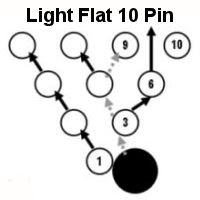Common Reasons for Leaving the 10 Pin in Bowling
This bowling tips article is on why we leave the ten pin bowling. This is for right-handed bowlers, you lefties will have to reverse everything for the 7 pin.
First we must understand that there are two basic reason we leave 10 pins: Hitting Heavy and Hitting Light
Hitting light sends the 6 pin straight backwards, hitting heavy causes a Ringing/Wrap 10 pin. The light hit is caused by the ball’s lack of energy when entering the pocket, or a poor angle of entry. Conversely, a heavy hit or ringing ten (seven for lefties) is caused by a ball having too much energy left or a very severe angle of entry. Both shots can leave the same result, the dreaded 10 pin.
Hitting Light
When you are hitting light, the 3 pin hits the front of the 6, sending it to the left of the 10 pin. This can be recognized by watching your strike shot and what would look like a very solid hit, will leave the 10-pin due to the fact that the 3 pin is hitting the 6 pin to far to the right, sending the 6 pin to the left of the 10 pin. You can recognize you are hitting light by watching the 6-pin. If the 6 pin is missing the 10 pin to the left then it is likely that you are hitting light.

Hitting Heavy
When you are hitting heavy, the 3 pin usually heads straight back, which sends the 6 sideways to lay in the channel. We leave the 10 pin because the ball lost energy before it enters the 1 -3 pocket and the ball will hit heavy (more on the head pin). This could be because a few things:
The ball is all rolled out and has rolled early and then hits flat, or the ball hits a spot of conditioner carry down on the bowling lane and it come in week or late.
Typically you will see the 6-pin lying in the gutter after you shot or “ringing” the 6 pin around the 10 pin.

How Do We Fix Leaving the 10 Pin?
From the above, identify the type of ten pin you are leaving, then make the proper adjustment to solve it.
Fixing Hitting Light
If you are leaving 10’s by hitting the 6 pin to the left of the 10 pin, you probably need a earlier roll into the pocket. This can be accomplished by changing hand position, reducing ball speed or changing to a ball that has a earlier roll. When you are hitting light, the flat 10 requires a change in entry angle. First, try hitting the 1-3 slightly higher to send the 3 more to the right, which helps the 6 do it’s job.
Here are two simple methods that will help fix hitting light:
- Move 1 to 2 and 1/2 boards right on the approach but keep your same target.
- Move 4-6 inches backward on the approach but keep your same target.
Fixing Hitting Heavy
If you are leaving ringing 10’s by hitting the 6 pin to the right of the 10 pin, you probably need a later roll into the pocket and/or change the angle the ball is hitting the pocket.
Here a two simple methods that will help fix hitting heavy:
- Move 1 to 21/2 boards left on the approach but keep your same target.
- Move 4-6 inches forward on the approach but keep your same target.
Hints:
While bowling, take note of what the 3 and 6 pins are doing. If you see the 6 going in front of the 10, you’re most likely coming in heavy, and if you see the 6 going to the left of the 10, you’re probably coming in light.
- Depending on lane conditions, you may need to move both your mark and your stance equally.
- If you are not hitting your mark, don’t change anything until you hit your mark. To many bowlers will move on bad shots when there is no need to move because you never hit your mark in the first place.
- The ringing 10 can simply be considered bad luck, it is the better of the two foes. Most of the time you don’t have to adjust much to fix the ringing 10.
Learning how to recognize and adjust will help stop leaving that dreaded 10 pin and will greatly improve your bowling score.



